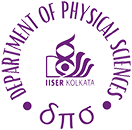Undergrad vision: Young physicists' symposium
Time: 2:00 PM IST
Venue: Asima Chatterjee Lecture Theatre, 2nd Floor, RC
This unique initiative by Gluon offers the younger members of DPS, along with other BS-MS students, a platform to share their insights with peers. In our opening session, six speakers will present their ideas on various fields, ranging from astrophysics to condensed matter physics.
Speakers:
1. Archis Mukhopadhyay: Looking for magnetized jellyfish in a toy Universe
Abstract: Large scale cosmological hydrodynamical simulations can provide us with a wide range of information about galaxies, galaxy clusters, and the multiphase gas in and around galaxies. They provide us with large samples of galaxies in realistic environments, and allow us to infer information about galaxies at a population level. In this talk, I will give a brief introduction to IllustrisTNG, how large simulation data is handled, and the preliminary results from my analysis.
2. Bhaskar Barman: Hot electron relaxation in Metals
Abstract: In this talk we will review of the phenomena related to non-equilibrium electron relaxation in metals using two temp. model .Considering the Boltzmann-Bloch-Peierls (BBP) kinetic equation ,we will find the net phonon generation rate and derive the average energy transfer relation between electron and phonon in low and high temperature limit .
3. Sabarinath M D: Mapping the moon
Abstract: The talk will cover the procedures involved in element mapping on Lunar Surface, using the data of Chandrayaan 2 CLASS payload. I shall also tell about the practical difficulties and some unique findings on the moon surface during the internship. I will provide some interesting methodologies employed and some great features of the X ray range emissions of the moon.
4.Rohan Kumar: Developing a flare detection pipeline to characterize the flare frequency distribution around low mass stars
Abstract: In this talk , I am going to discuss my work related to developing a stellar flare detection pipeline in Python. It has been tested it on optical light curve data from NASA\\\\\\\\\\\\\\\\\\\\\\\\\\\\\\\'s Transiting Exoplanet Surveyed Satellite. Our pipeline can be broken down into two steps; first, we detrend the light curve to remove the long-term variation or quasi-periodic stellar rotation from the light curve; second, we search for the flares in the detrended light curve. The flare search is performed by classifying significant contiguous outliers, which makes the detection entirely data-driven.We performed injection-recovery tests to tune the flare search parameters to maximize the detection efficiency while keeping the false positive rate low. Our injection recovery test clearly shows the importance of higher cadence observations and the optimal flare search parameters. Our pipeline will ultimately be used to generate flare frequency distribution for mid-to-late M dwarfs.
5.R.Pradeep: Quantum Communication methods for secure communication: Quantum key distribution, Quantum secret sharing and Quantum dialogue protocols.
Abstract: Secure communication between parties can be done using the quantum properties like superposition and entanglement. If security is based on one way computable functions like prime factorisation , it could bee broken through quantum algorithms like Shors algorithm. If we design our security based on laws of quantum mechanics then it would be unconditionally secure and some of the few standard methods will be discussed in this talk.
6.Sanghamitra Basu: Exploring stress and strain in doped β-Ga2O3 crystals.
Abstract:Powder X-ray diffraction studies were conducted on undoped β-Ga2O3 crystals and nine samples doped with various 3d transition metals, starting from Scandium. Our comparative analysis focused on the chemical pressure induced within the lattice by the different dopants used such as strain and twist. Experimental data was fitted using the FullProf Suite, employing the Profile Matching with Constant Scale Factor method to extract precise lattice parameters. Additionally, the Modified-Williamson Hall plot was utilized to investigate the variations in mechanical microstrain along different crystallographic directions and across the doped samples. We additionally annealed 2 samples (undoped and V-doped) to see the changes in microstrain using the same Modified Williamson-Hall method. This comprehensive study provides new insights into the structural and mechanical impacts of transition metal doping in β-Ga2O3 crystals.
#Events
Posted on: August 23rd, 2024

